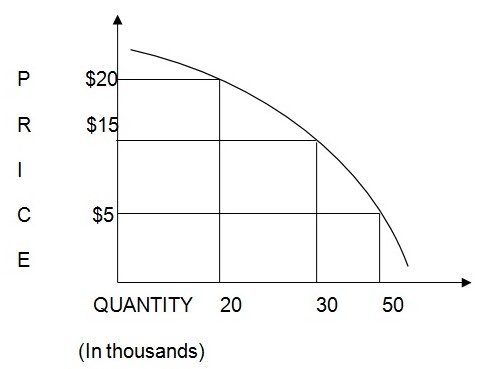Effect of revenue when there is a change in price
“Revenues are receipts from selling of produced goods and provided services, purchased goods and stocks, useless assets, patents and licenses, etc” (Krizanova, & Hrivnak, n.d., p.78). The value of revenue is recorded in the profit and loss account of the respective organization. When product’s price is increased its demand reduces and it leads to decreased revenue. The firm Will Bury has developed a technology where there is a choice for reading the materials that are in a digital format and it can be listened with the help of a voice that are synthesized. This voice is very realistic. Will Bury scenario mainly concentrate on the back bone of market which is termed as ‘demand and supply’. Demand means quantity of products for which the consumers are in need. Supply means distributing the quantity of products that are demanded by the consumers. Both are directly related to each other. When demand increases the supply also increases and when demand decreases the supply also decreases. The increased change in price of a product will lead to an increased change in the demand for the product and ultimately affect the supply of the product. It leads to the reduction in the revenue earned by the product. When price decreases the demand for the product increases which ultimately leads to increase in revenue. Currently, the industry offers 500 pages of books on CD at a price of $20. (Remus, 2009). But, if the competitors reduce the price, the customers of Will Bury will switch to the substitute product which will result in low demand for the Will Bury product and high demand for the substitute product which directly results in decreased revenue for Will Bury.
Estimating the elasticity of demand in Will Bury scenario based on the estimation on the number of substitutes by using arc method
The elasticity of demand means rate of change in the quantity of products demanded by the consumers to the rate of changes made in the price. “One type of elasticity of demand is to calculate the ratio of the percentage change in quantity demanded of a product to the percentage change in its price. This is known as the price elasticity of demand (Ed = the percentage change in quantity demanded of a product over the percentage change in price)” (Remus, 2009, Elasticity of demand, para.1).Substitute products are those products that can be compared and used instead of other product. Before introducing its product into the market, it must analyze the number of consumers ready to buy the product, number of substitutes available, price of the related goods, buyers’ income and buyers’ preferences. To digitalize the copy righted books, extra charge is required. The current charge is $5. The current pricing strategy is $15 for copy righted books and $10 for non-copy righted books. This change in demand and price is represented in an arc. The figures in the diagram are just assumptions.

Justification for the elasticity of demand
“Depending upon the responsiveness to price changes, demand elasticity can be elastic or inelastic as described by the angle of the demand curve. The flatter the curve, the more price elastic, while a steeper curve would mean more price inelastic.” (Demand elasticity, 2009, para.1). In the diagram, the price at $15 indicates that the quantity demanded for the product is 30. If the price increases to $20, then we can see that the quantity demanded for the product is reduced to 20. The quantity demanded has been reduced from 30 to 20. Suppose if the price is reduced to $5 we can see an increasing change in the quantity demanded by the consumer. This shows that the price plays a significant role in estimating the demand for the product. From this diagram it is very clear that the increase in price of the product will lead to the decrease in the quantity of product demanded by the consumer.
Reference
Demand elasticity. (2009). Investor Glossary. Web.
Krizanova, A., & Hrivnak, M. (n.d.). The analysis of demand and price effect on firm’s revenue: Determination of a firm’s revenue. Vadyba / Management. Web.
Remus (2009). Question: Will Bury’s Price elasticity scenario. Just answer. Home. Web.
Remus. (2009). Question: Will Bury’s Price elasticity scenario: Elasticity of demand. Web.